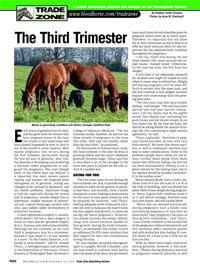Trade Zone: The Third Trimester - Click Here to Download PDF
 By Heather Smith Thomas
By Heather Smith Thomas
Each phase of gestation has its risks, and the good news for owners who have pregnant mares in the barn this winter is that most losses will have already happened by now, so they’re out of the woods in some respects. Most equine pregnancy loss occurs during the first trimester, particularly during the first 60 days of gestation; after that, the placenta is developing and producing a hormone called progesterone to safeguard the pregnancy. But even though some of the riskier days are behind, it is important that mare owners remain vigilant and monitor the pregnant mare throughout all of gestation, noting any changes in her attitude or demeanor, and any health problems. Important things to look for, especially during the second half of pregnancy, include weight loss or depression, sudden increase in abdominal size, vaginal discharge, periodic mild colic, and sudden udder development or premature lactation.
A mare’s gestation is roughly 11 months, which doesn’t fall into a neat category of thirds as other species’ gestation lengths do (i.e., humans and cattle at nine months). Defining the last trimester as the final third of pregnancy may be a misnomer, because it may entail 3 1/2 to four months in a mare. “In the French literature, a trimester is three months,” said Dr. Ahmed Tibary, a theriogenologist and professor in the Department of Veterinary Clinical Sciences at Washington State University’s College of Veterinary Medicine. “The last trimester would, therefore, be just the last three months of pregnancy in the mare (the ninth, 10th, and 11th month), rather than the final third,” he explained.
All discussions of nomenclature aside, this final trimester is the time the fetus is growing fastest and the mare’s abdomen generally becomes larger. Tibary says this is also when a lot of the changes in the mare take place to prepare for the safe arrival of a healthy foal.
To continue reading, click the "Download" button at the bottom of this page.
Sponsors:
Dandy Products (http://www.dandyproductsinc.com/)
Doc’s Equine Products (http://www.ocdpellets.com/)
Equiade Products (http://www.equiade.com/)
Life Data Labs, Inc. (http://www.lifedatalabs.com/)
The Pond Lady (http://www.thepondlady.com/)
Archives:
Ready to Run - October 31, 2009
Feeding For the Ages - September 19, 2009
Transportation Tips - September 5, 2009
Disease Control Yearly Planner - August 8, 2009
Foot Flops & Fixes - July 25, 2009
Get Ready - June 26, 2009
Therapy For Thoroughbreds - May 5, 2009
Dirt or Synthetic - Which is Safer? - April 25, 2009
AAEP: Focus on Horse Health News - March 21, 2009
Infectious Disease at the AAEP Convention - February 21, 2009
When Foaling Goes Wrong - December 6, 2008
Feeding the Pregnant Mare - November 15, 2008
Broodmare Vaccinations - November 1, 2008
Transport Stress in Horses - October 18, 2008
View more...




